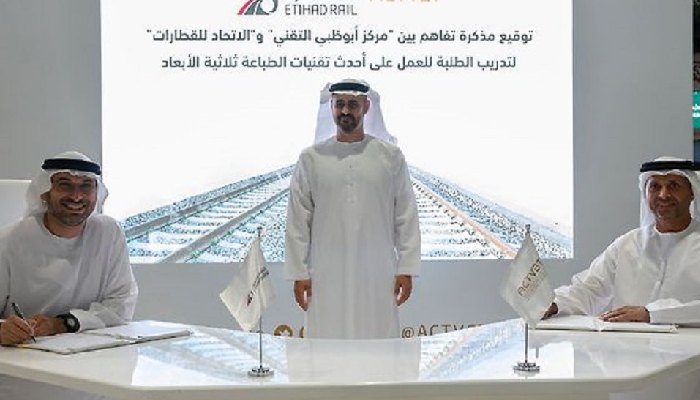His Highness Sheikh Theyab bin Mohamed bin Zayed Al Nahyan, Chairman, Etihad Rail, graced the signing of an MoU between Abu Dhabi Centre for Technical and Vocational Education and Training (ACTVET) and Etihad Rail. The duo will exchange knowledge in the field of advanced technologies, and work on the latest 3D printing technologies that utilise recycled resources, supervised by young Emirati students and graduates at the Abu Dhabi Centre for Technical and Vocational Education and Training.
Under the MoU, the two parties will establish new collaboration streams in regard to designing and producing environmentally friendly resources using the latest technologies, by qualifying young citizens, in line with supporting government sustainability initiatives and national competencies specialised within the industrial sector.
His Excellency Dr. Mubarak Saeed Al Shamsi, Director General, ACTVET said, “This agreement constitutes a new pioneering initiative at ACTVET, which utilises the latest technologies in the design and production of spare parts and accessories, including three-dimensional printing, lathing, environmentally friendly recycled resources, and other technologies. He emphasised that the MoU aims to qualify Emirati manpower to work on the latest technologies for three-dimensional printing and its accessories, in a way that encourages the participation of more national talents with specialisations in the industrial sector of the UAE.”
His Excellency Shadi Malak, CEO, Etihad Rail, expressed his ambitions for Etihad Rail to continue its role in supporting Emirati manpower, and benefiting from ACTVET’s expertise to qualify them professionally and technically in the field of three-dimensional printing according to Etihad Rail’s needs in developing the railway sector.
He said, “Our wise leadership has continuously empowered our nation’s youth as they are a vital part in the development of all sectors and the drivers of continued growth and progress.”
The use of recycled materials helps companies achieve their sustainability goals by improving resource efficiency, and therefore enhancing the environment, by reducing waste from production and manufacturing processes and protecting natural resources. Sustainable use of materials can also improve long-term profitability by reducing costs associated with materials waste and minimising pollution.
3D printing technology allows the production of parts and components with high precision, speed and lower costs compared to traditional methods of manufacturing, as well as saves energy by reducing the number of steps required to operate the equipment needed to produce manufacturing moulds, tools, and equipment.
previous post

